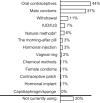International survey to assess women's attitudes regarding choice of daily versus nondaily female hormonal contraception
- PMID: 24729734
- PMCID: PMC3979785
- DOI: 10.2147/IJWH.S59059
International survey to assess women's attitudes regarding choice of daily versus nondaily female hormonal contraception
Abstract
Background: The availability of reliable contraception tailored to suit women's needs and lifestyles is an essential step in addressing unintended pregnancy and its substantial human and financial costs. The daily combined oral contraceptive pill has been the short-acting hormonal contraceptive of choice for the last 50 years. However, for some women, this may be neither suitable nor optimal.
Methods: Here we report the findings of a large, online, questionnaire-based study conducted in Brazil, France, Germany, Italy, and the USA. The study was designed to assess women's attitudes, beliefs, and unmet needs regarding current hormonal contraceptive options via an anonymous online survey. Women eligible for contraception were required to respond to questions using either a binary (yes/no) or seven-point scale (1, complete disagreement; 7, complete agreement). Women were also asked about other relevant issues, such as lifestyle, perception of menstruation and pregnancy, level of education, and relationship with their health care professional.
Results: In total, 12,094 women were questioned, of whom 68% required contraception. Overall, 28% of women expressed an interest in novel contraceptive products, and 49% stated that they would prefer a nondaily method. Although many women expressed satisfaction with the pill, daily intake was thought to be burdensome, resulting in irregular and ineffective usage. However, many women continued to choose the pill due to lack of consideration of and education about other options. Approximately half of the women wished to conceive in the near future.
Conclusion: The findings indicate that nearly half of respondents would prefer a nondaily form of contraception. Furthermore, approximately half of respondents wished to conceive in the near future, suggesting that they are unlikely to favor long-acting options. Effective education on contraceptive choices may help women to find the method that best suits their needs, thus improving contraceptive compliance.
Keywords: contraceptive options; female contraception; hormonal contraceptives; survey; women’s attitudes.
Figures





References
-
- Klima CS. Unintended pregnancy. Consequences and solutions for a worldwide problem. J Nurse Midwifery. 1998;43:483–491. - PubMed
-
- Hooper DJ. Attitudes, awareness, compliance and preferences among hormonal contraception users: a global, cross-sectional, self-administered, online survey. Clin Drug Investig. 2010;30:749–763. - PubMed
-
- Glasier A, Scorer J, Bigrigg A. Attitudes of women in Scotland to contraception: a qualitative study to explore the acceptability of long-acting methods. J Fam Plann Reprod Health Care. 2008;34:213–217. - PubMed
-
- Beligotti F, Gordon K. Findings from the International I Plan On… Survey: women’s awareness, misconceptions, and preferences regarding their contraceptive options [poster abstract] Eur J Contracept Reprod Health Care. 2012;17(S1):S98.
LinkOut - more resources
Full Text Sources
Other Literature Sources

